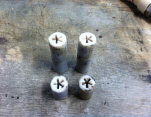
Blog
Fisher Space Systems LLC
Viper Rocket Trike
Updated Jan 2023
12-31-2022: I tested a 13.5 cm high flux PLA/KMnO4 fuel core. The objective of this test was to increase the O/F ratio. Ignition occurred in ~ 1.3 sec with ~ 4.2 sec of thrust. From the video, I was able to deduce the mass flow rate. As such, the O/F ratio was ~ 4.0. The L/D was 8.8 and the initial surface flux was ~ 0.24 gm/cm2/sec. From the test, it appears as though the L/D is the dominate parameter as opposed to the initial surface flux. Dec 2022 EOM report.
11-30-2022: I upgraded my rocket engine test stand and ran two tests on the HF fuel core, one of which was on the new test stand. On the second test, I increased the HTPE load to 62.4 ml. Ignition occurred in ~ 0.8 seconds and lasted ~ 5.0 seconds. The thrust was ~ 24 N and the c* efficiency was ~ 91%. Total propellant load was ~ 105 gm. Nov 2022 EOM report.
10-31-2022: I used some similarity scaling parameters to increase the thrust of the HTPE/PLA hybrid rocket engine. The objective is to increase launch velocity and thus aerodynamic control of the Mk I Viper rocket glider. The three scaling parameters I looked at were initial gas flux, initial surface area flux, and length to diameter ratio. I designed and printed a higher flux fuel grain and inserted a variable PLA flow restrictor at the end of the fuel core. My average thrust went from ~19 N to ~23 N and overall performance was on par with previous test. Oct 2022 EOM report.
09-30-2022: This month I optimized the expansion ratio of the nozzle to 1.8 in an effort to improve the thrust coefficient efficiency. I had a average thrust of ~ 19 N for about 4.4 seconds. However, in my first test, there was no increase in the thrust coefficient efficiency. I plan on keeping the expansion ratio to 1.8 and adjusting the flow rate, fuel core length, and characteristic length. Also, I achieved a 3 to 4 m/sec launch velocity by launching at a 30 degree angle. Sept 2022 EOM report.
08-31-2022: I spent most of the month identifying failure modes such as nozzle blow outs, pinhole leaks, and loose connections. Having resolved the problems, I had a successful test with a flow rate of ~ 23 ml/sec toward the end of the month. The thrust reached a peak of ~ 35 N and then declined ~ 24 N. Overall performance was pretty lousy with the c* and Ceff efficiency at 74% and 66% respectively. However, my O/F ratio was ~7.5, way to high. Read more in the Aug 2022 EOM report.
07-31-2022: The first two flight test with the new throat diameter of 6.7 mm did not go well! In the first test, the Mk I Viper made it to the top of the rail guide, blew out the nozzle, lost thrust, broke through the stop, came off the rail guide, and crashed onto the concrete pad. In the second test, the Mk I Viper left the rail guide at ~ 1.5 m/sec, began to pitch up, blew out the nozzle, flipped over once, and crash landed next to the test stand. Analysis shows that I may have exceeded the structural limit on drilling out a larger diameter throat on the graphite phenolic nozzle. I went back to the 6.0 mm diameter and increased the flow rate for the nozzle. Keeping all other parameters the same, I got ~ 140 psig pressure spike in the mixing chamber. The pressure spike blew out the nozzle. The next test will have a variable flow control. This should reduce the pressure spike and produce a stable combustion. Read more in the Jul 2022 EOM report.
06-30-2022: This is the first launch of the Mark I Viper. The Mk I Viper cleared the rail guide at 2 m/sec and it was under thrust for ~ 7 seconds. I used 50 ml of unstabilized ~ 90% HTP plus 2 ml of ethanol for the oxidizer and PLA infused with KMnO4 for the fuel. Ignition occurred in ~ 0.3 seconds. The mass flow rate was about 13.29 gm/sec resulting in a total propellant mass of ~ 93.0 gm for the 7.0 seconds of thrust. I expected the Mk I viper to clear the rail guide at 4 m/sec. As such, I didn't have the aerodynamic control I needed to correct the trajectory. To prevent it from pitching forward, I'll shift the center of mass more in line with the thrust vector. Also, I'll increase the thrust to give me more aerodynamic control. Read more in the Jun EOM report.
05-31-2022: This month I measured the thrust at 19.1 N and it looked pretty steady. I increased the thrust by increasing the throat diameter to 6 mm which resulted in a slight increase in mass flow rate. The characteristic velocity was calculated to be ~1662 m/sec with an efficiency of 104% . Also, I've been working on the flight system. I have rearranged the mass some with the purpose of moving the CM more in line with the thrust vector. Next month, I plan to launch the Mark I Viper. Read more in the May EOM report.
04-30-2022: This month, I did a static engine test of the flight system. The thrust ramped up from ~15 N to around 20 N over a 7 sec burn time. The longer than usual burn time is attributed to ignition occurring in ~0.3 sec and thus leaving more oxidizer to fuel the engine. This was due to a small amount of HTPE leaking into the fuel grain during initialization of the receiver, a preheating event.
The center of mass (CM) is below the cockpit area and ~ 2 cm off the thrust vector. The off axis thrust will cause the Viper to rotate after leaving the guide rail. Due to the low thrust at ignition, the liftoff velocity will not be enough to correct the rotation of the MkI Viper using the elevators and the vertical stabilizer. I will rearrange the masses inside the fuselage and bring the CM closer to the line of thrust. Also, I believe I can increase the thrust by increasing the initial nozzle throat diameter from 5 to 6 mm. Read all about it in the April EOM report.
03-31-2022: This month, I mounted a static engine test stand, a load cell to measure thrust, and a test article with a blast shield around the oxidizer tank to my rocket engine test stand. To run a static engine test, I need to pressurize the oxidizer tank to 140 psig and turn off the fill valve. Adding a blast shield around the oxidizer tank makes it safer and is part of my KISSES principle of "Keeping it Safe". Over the next month or two I'll be testing fuel grain lengths of 11.5, 12.5, and 13.5 cm to narrow done the ideal fuel grain lengths for best overall performance. Read more in the March EOM report.
02-28-2022: This month, in an attempt to increase the thrust of the class I engine, I increased the O/F ratio by shortening the fuel grain from 15 cm to 12.5 cm. This reduced the contact surface area of the fuel grain and also, reduced the mass of the rocket engine by about 20 gm. Ignition occurred around 0.9 sec with a characteristic velocity (c*) of 1,521 m/sec and a c* efficiency of over 100%. I observed a net positive thrust of greater than 19.1 N at ignition .
Also this month, I printed a 15 cm PLA/Al fuel core using off the shelf aluminized PLA with an aluminum content of ~ 13%. I infused the PLA/Al fuel core with KMnO4 and assembled a rocket engine based on the PLA/Al/KMnO4 fuel core. All other parameters were the same. Ignition occurred in ~ 1.3 sec and burn time was ~ 5.8 sec. The c* was 1,477 m/s with a c* efficiency of 96%. This too looks promising. If ignition time is reduced by running the engine oxidizer rich as noted above, it may be worth pursuing. Also, using a finer grain of Al with the PLA may improve performance. Read more in the February EOM report.
01-30-2022: This month I worked on the forward and aft struts for the cockpit, the paraglider box, the battery pack, and the placement of the RC receiver and the servos. I inserted the oxidizer tank and fuel grain (pictured below) into the carbon fabric fuselage. Everything fits and is ready for static testing. The mass is ~1.3 kg including the oxidizer and fuel. Read more in the January EOM report.
11-30-2022: I upgraded my rocket engine test stand and ran two tests on the HF fuel core, one of which was on the new test stand. On the second test, I increased the HTPE load to 62.4 ml. Ignition occurred in ~ 0.8 seconds and lasted ~ 5.0 seconds. The thrust was ~ 24 N and the c* efficiency was ~ 91%. Total propellant load was ~ 105 gm. Nov 2022 EOM report.
10-31-2022: I used some similarity scaling parameters to increase the thrust of the HTPE/PLA hybrid rocket engine. The objective is to increase launch velocity and thus aerodynamic control of the Mk I Viper rocket glider. The three scaling parameters I looked at were initial gas flux, initial surface area flux, and length to diameter ratio. I designed and printed a higher flux fuel grain and inserted a variable PLA flow restrictor at the end of the fuel core. My average thrust went from ~19 N to ~23 N and overall performance was on par with previous test. Oct 2022 EOM report.
09-30-2022: This month I optimized the expansion ratio of the nozzle to 1.8 in an effort to improve the thrust coefficient efficiency. I had a average thrust of ~ 19 N for about 4.4 seconds. However, in my first test, there was no increase in the thrust coefficient efficiency. I plan on keeping the expansion ratio to 1.8 and adjusting the flow rate, fuel core length, and characteristic length. Also, I achieved a 3 to 4 m/sec launch velocity by launching at a 30 degree angle. Sept 2022 EOM report.
08-31-2022: I spent most of the month identifying failure modes such as nozzle blow outs, pinhole leaks, and loose connections. Having resolved the problems, I had a successful test with a flow rate of ~ 23 ml/sec toward the end of the month. The thrust reached a peak of ~ 35 N and then declined ~ 24 N. Overall performance was pretty lousy with the c* and Ceff efficiency at 74% and 66% respectively. However, my O/F ratio was ~7.5, way to high. Read more in the Aug 2022 EOM report.
07-31-2022: The first two flight test with the new throat diameter of 6.7 mm did not go well! In the first test, the Mk I Viper made it to the top of the rail guide, blew out the nozzle, lost thrust, broke through the stop, came off the rail guide, and crashed onto the concrete pad. In the second test, the Mk I Viper left the rail guide at ~ 1.5 m/sec, began to pitch up, blew out the nozzle, flipped over once, and crash landed next to the test stand. Analysis shows that I may have exceeded the structural limit on drilling out a larger diameter throat on the graphite phenolic nozzle. I went back to the 6.0 mm diameter and increased the flow rate for the nozzle. Keeping all other parameters the same, I got ~ 140 psig pressure spike in the mixing chamber. The pressure spike blew out the nozzle. The next test will have a variable flow control. This should reduce the pressure spike and produce a stable combustion. Read more in the Jul 2022 EOM report.
06-30-2022: This is the first launch of the Mark I Viper. The Mk I Viper cleared the rail guide at 2 m/sec and it was under thrust for ~ 7 seconds. I used 50 ml of unstabilized ~ 90% HTP plus 2 ml of ethanol for the oxidizer and PLA infused with KMnO4 for the fuel. Ignition occurred in ~ 0.3 seconds. The mass flow rate was about 13.29 gm/sec resulting in a total propellant mass of ~ 93.0 gm for the 7.0 seconds of thrust. I expected the Mk I viper to clear the rail guide at 4 m/sec. As such, I didn't have the aerodynamic control I needed to correct the trajectory. To prevent it from pitching forward, I'll shift the center of mass more in line with the thrust vector. Also, I'll increase the thrust to give me more aerodynamic control. Read more in the Jun EOM report.
05-31-2022: This month I measured the thrust at 19.1 N and it looked pretty steady. I increased the thrust by increasing the throat diameter to 6 mm which resulted in a slight increase in mass flow rate. The characteristic velocity was calculated to be ~1662 m/sec with an efficiency of 104% . Also, I've been working on the flight system. I have rearranged the mass some with the purpose of moving the CM more in line with the thrust vector. Next month, I plan to launch the Mark I Viper. Read more in the May EOM report.
04-30-2022: This month, I did a static engine test of the flight system. The thrust ramped up from ~15 N to around 20 N over a 7 sec burn time. The longer than usual burn time is attributed to ignition occurring in ~0.3 sec and thus leaving more oxidizer to fuel the engine. This was due to a small amount of HTPE leaking into the fuel grain during initialization of the receiver, a preheating event.
The center of mass (CM) is below the cockpit area and ~ 2 cm off the thrust vector. The off axis thrust will cause the Viper to rotate after leaving the guide rail. Due to the low thrust at ignition, the liftoff velocity will not be enough to correct the rotation of the MkI Viper using the elevators and the vertical stabilizer. I will rearrange the masses inside the fuselage and bring the CM closer to the line of thrust. Also, I believe I can increase the thrust by increasing the initial nozzle throat diameter from 5 to 6 mm. Read all about it in the April EOM report.
03-31-2022: This month, I mounted a static engine test stand, a load cell to measure thrust, and a test article with a blast shield around the oxidizer tank to my rocket engine test stand. To run a static engine test, I need to pressurize the oxidizer tank to 140 psig and turn off the fill valve. Adding a blast shield around the oxidizer tank makes it safer and is part of my KISSES principle of "Keeping it Safe". Over the next month or two I'll be testing fuel grain lengths of 11.5, 12.5, and 13.5 cm to narrow done the ideal fuel grain lengths for best overall performance. Read more in the March EOM report.
02-28-2022: This month, in an attempt to increase the thrust of the class I engine, I increased the O/F ratio by shortening the fuel grain from 15 cm to 12.5 cm. This reduced the contact surface area of the fuel grain and also, reduced the mass of the rocket engine by about 20 gm. Ignition occurred around 0.9 sec with a characteristic velocity (c*) of 1,521 m/sec and a c* efficiency of over 100%. I observed a net positive thrust of greater than 19.1 N at ignition .
Also this month, I printed a 15 cm PLA/Al fuel core using off the shelf aluminized PLA with an aluminum content of ~ 13%. I infused the PLA/Al fuel core with KMnO4 and assembled a rocket engine based on the PLA/Al/KMnO4 fuel core. All other parameters were the same. Ignition occurred in ~ 1.3 sec and burn time was ~ 5.8 sec. The c* was 1,477 m/s with a c* efficiency of 96%. This too looks promising. If ignition time is reduced by running the engine oxidizer rich as noted above, it may be worth pursuing. Also, using a finer grain of Al with the PLA may improve performance. Read more in the February EOM report.
01-30-2022: This month I worked on the forward and aft struts for the cockpit, the paraglider box, the battery pack, and the placement of the RC receiver and the servos. I inserted the oxidizer tank and fuel grain (pictured below) into the carbon fabric fuselage. Everything fits and is ready for static testing. The mass is ~1.3 kg including the oxidizer and fuel. Read more in the January EOM report.
"Simplicity is the ultimate sophistication."
- Leonardo da Vinci
This work is licensed under the Creative Commons Attribution-ShareAlike 4.0 International License. To view a copy of this license,
visit
http://creativecommons.org/licenses/by-sa/4.0/
Copyright (c) 2021 Jerry F Fisher
http://creativecommons.org/licenses/by-sa/4.0/
Copyright (c) 2021 Jerry F Fisher






































